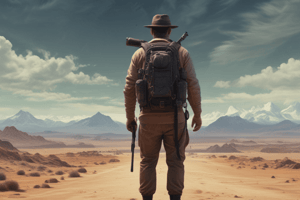Podcast
Questions and Answers
Match the cinematic terms with their definitions:
Match the cinematic terms with their definitions:
Ominous = Threatening Long Shot = Establishing shot Close-ups = Shots showing a character's face in detail Director = Person who directs the film Screenwriter = Person who writes the film's script
What is a 'close-up' in film terminology?
What is a 'close-up' in film terminology?
- A type of wide shot
- A shot focusing on a character's face (correct)
- A long shot for establishing context
- A shot showing a full body
A sequence is composed of multiple scenes with a change of location or time.
A sequence is composed of multiple scenes with a change of location or time.
True (A)
The __________ shot is when the camera is placed below the subject, looking up.
The __________ shot is when the camera is placed below the subject, looking up.
What is the term for the person who oversees the creative aspects of a film?
What is the term for the person who oversees the creative aspects of a film?
Flashcards are hidden until you start studying
Study Notes
Vocabulary
- Ominous means threatening
- Threat means menace
- Long Shot is synonymous with establishing shot and wide shot
- Close-ups offer intimacy in the scene
- High Angle shots are known as "plongée" in French
- Vulnerability is often highlighted through extreme close-ups
Film Analysis
- Scene is made up of several "shots" that occur at the same location and time
- Sequence comprises several scenes, with shifts in time or location
- Shot refers to a single continuous recording of the scene
- Director is the person responsible for the overall vision of the movie
- Cinematography is the art of filming the movie
- Soundtrack refers to the overall sound effects and music in the film
- Camera Range includes the establishing shot, wide shot, medium shot, close-up, and extreme close-up
Camera Angles
- Three-Quarter Medium Long Shot (Plan Américain de trois quarts) positions the character slightly turned away from the camera
- Frontal Medium Full Shot (Plan Américain Frontal) showcases the character facing the camera at a medium distance
- Backshot (Plan de dos) shows the character from behind
- High-Angle Shot (Plongée) places the camera higher than the subject, often making the subject appear smaller and weaker
- Low-Angle Shot (Contre-plongée) positions the camera below the subject, which can make them seem more dominant or imposing
- Screenshot (Photogramme) is a still image extracted from the film
- Overhead Shot (Bird's Eye View / Plongée Totale) captures the scene from 90 degrees above the subject, presenting the frame from a direct top-down perspective
Studying That Suits You
Use AI to generate personalized quizzes and flashcards to suit your learning preferences.




